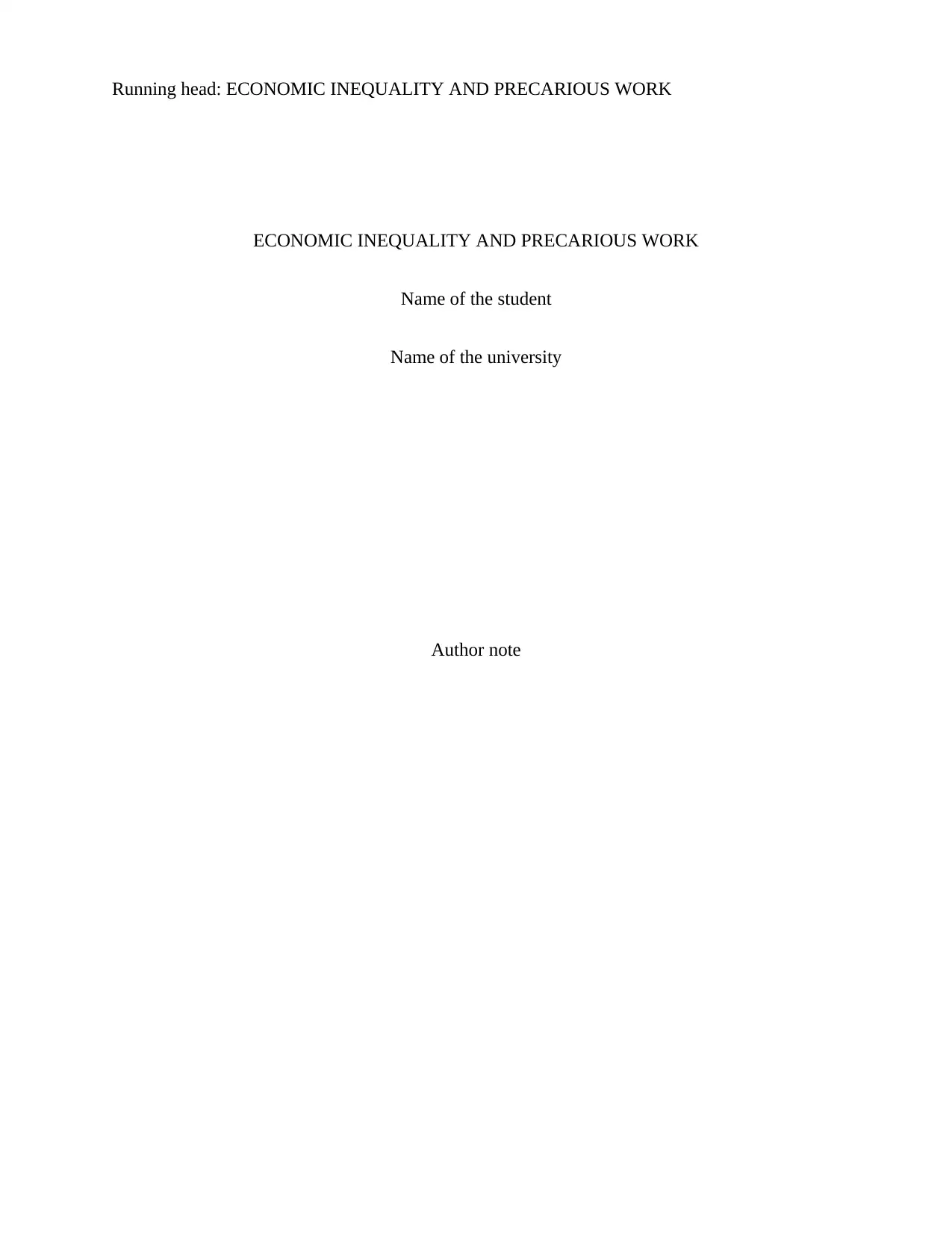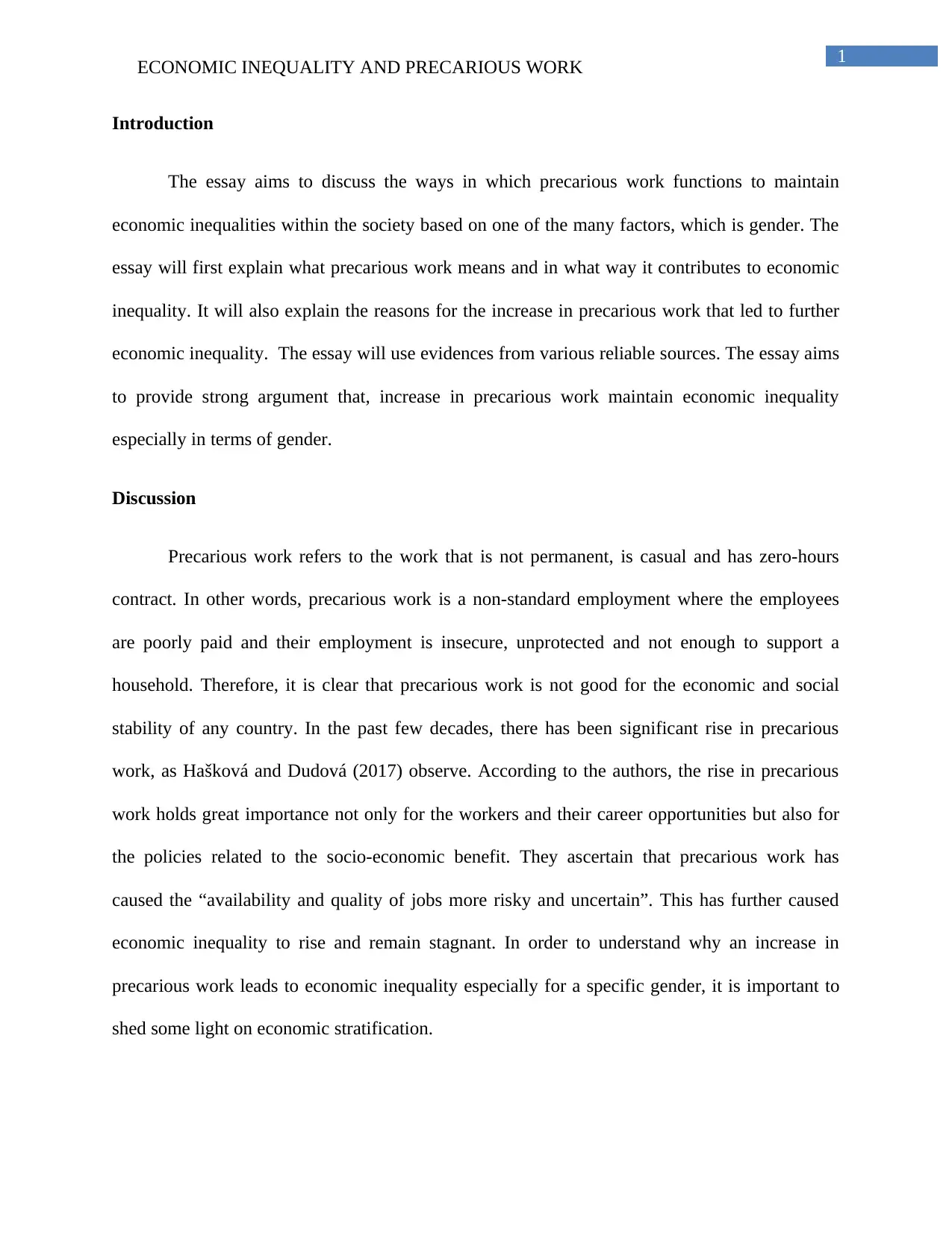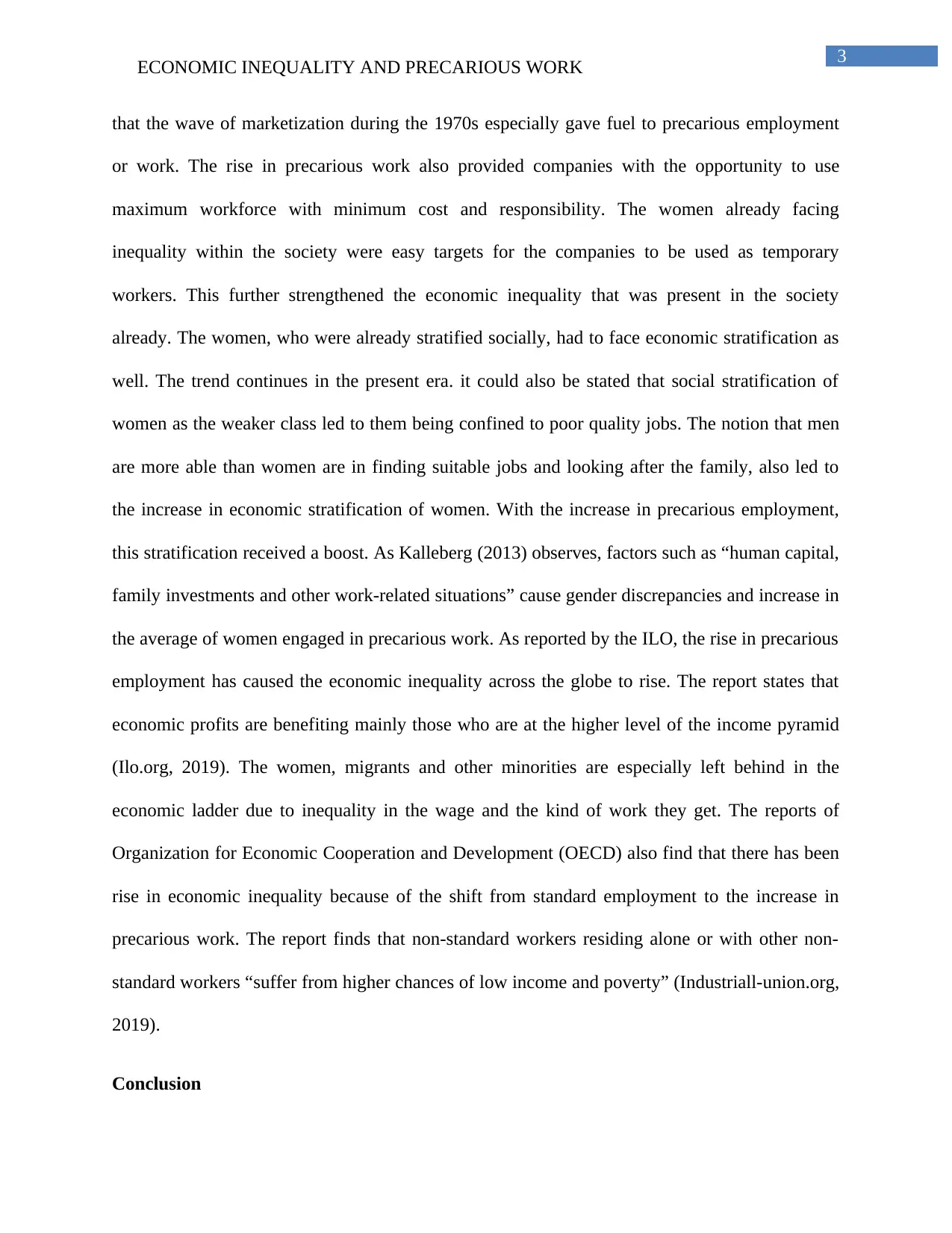University Essay: Economic Inequality and Precarious Work Analysis
VerifiedAdded on 2022/11/13
|6
|1282
|55
Essay
AI Summary
This essay delves into the ways precarious work sustains economic inequalities, with a specific focus on gender. It defines precarious work as non-standard employment characterized by insecurity, low pay, and lack of benefits. The essay argues that the rise of precarious work, driven by globalization and marketization, has exacerbated economic stratification, particularly affecting women. It cites research highlighting how women are disproportionately employed in precarious positions, leading to income inequality and hindering their economic stability, especially concerning pension. The essay uses evidence from various sources, including the ILO and OECD, to support its claims, concluding that precarious work perpetuates and increases economic inequality, especially for women and other minorities. The essay also discusses the historical context of precarious work, linking its rise to the initial phases of globalization and the subsequent trend of marketization. It provides a comprehensive analysis of the issue, using scholarly sources and reports from credible organizations.

Running head: ECONOMIC INEQUALITY AND PRECARIOUS WORK
ECONOMIC INEQUALITY AND PRECARIOUS WORK
Name of the student
Name of the university
Author note
ECONOMIC INEQUALITY AND PRECARIOUS WORK
Name of the student
Name of the university
Author note
Paraphrase This Document
Need a fresh take? Get an instant paraphrase of this document with our AI Paraphraser

1
ECONOMIC INEQUALITY AND PRECARIOUS WORK
Introduction
The essay aims to discuss the ways in which precarious work functions to maintain
economic inequalities within the society based on one of the many factors, which is gender. The
essay will first explain what precarious work means and in what way it contributes to economic
inequality. It will also explain the reasons for the increase in precarious work that led to further
economic inequality. The essay will use evidences from various reliable sources. The essay aims
to provide strong argument that, increase in precarious work maintain economic inequality
especially in terms of gender.
Discussion
Precarious work refers to the work that is not permanent, is casual and has zero-hours
contract. In other words, precarious work is a non-standard employment where the employees
are poorly paid and their employment is insecure, unprotected and not enough to support a
household. Therefore, it is clear that precarious work is not good for the economic and social
stability of any country. In the past few decades, there has been significant rise in precarious
work, as Hašková and Dudová (2017) observe. According to the authors, the rise in precarious
work holds great importance not only for the workers and their career opportunities but also for
the policies related to the socio-economic benefit. They ascertain that precarious work has
caused the “availability and quality of jobs more risky and uncertain”. This has further caused
economic inequality to rise and remain stagnant. In order to understand why an increase in
precarious work leads to economic inequality especially for a specific gender, it is important to
shed some light on economic stratification.
ECONOMIC INEQUALITY AND PRECARIOUS WORK
Introduction
The essay aims to discuss the ways in which precarious work functions to maintain
economic inequalities within the society based on one of the many factors, which is gender. The
essay will first explain what precarious work means and in what way it contributes to economic
inequality. It will also explain the reasons for the increase in precarious work that led to further
economic inequality. The essay will use evidences from various reliable sources. The essay aims
to provide strong argument that, increase in precarious work maintain economic inequality
especially in terms of gender.
Discussion
Precarious work refers to the work that is not permanent, is casual and has zero-hours
contract. In other words, precarious work is a non-standard employment where the employees
are poorly paid and their employment is insecure, unprotected and not enough to support a
household. Therefore, it is clear that precarious work is not good for the economic and social
stability of any country. In the past few decades, there has been significant rise in precarious
work, as Hašková and Dudová (2017) observe. According to the authors, the rise in precarious
work holds great importance not only for the workers and their career opportunities but also for
the policies related to the socio-economic benefit. They ascertain that precarious work has
caused the “availability and quality of jobs more risky and uncertain”. This has further caused
economic inequality to rise and remain stagnant. In order to understand why an increase in
precarious work leads to economic inequality especially for a specific gender, it is important to
shed some light on economic stratification.

2
ECONOMIC INEQUALITY AND PRECARIOUS WORK
The separation or stratification of various social classes within a society along economic
lines is referred to as economic stratification. It is important to note that economic stratification
and economic inequality possess different meanings and must not be confused as one. Economic
inequality in fact arises due to economic stratification. The increase of precarious work is one of
the glaring examples of the ways some specific social classes specifically in terms of gender are
economically stratified. Hašková and Dudová (2017) further found in their study in the European
Union especially in the Czech Republic, the increase in precarious work causing problems for
women with care responsibilities. The authors state that the increase in precarious work have
caused the women who are responsible for looking after their household to remain excluded from
a stable job. In recent times, more and more companies are opting for temporary employees
because this helps them reduce their overall cost and save themselves from the responsibility of
their workers as well. As per the International Labor Organization, there has been remarkable
increase in precarious work that has in turn, led to the increase in income inequalities. A strong
trend in such inequality indicates inequality in terms of gender. Sheen (2017) analyzed the
influence of precarious works on Australian women especially those who look for pension in
later age. The author states that higher rate of women than men are in need of pension because of
the kind of jobs they did. The author finds that “women are more likely to be sequestered in
precarious employment, with reduced job quality and a greater potential for premature workforce
exit”. It is important for the government, organizations and businesses to understand that the rise
in precarious employment especially for women might benefit for a short-term but deteriorates
the economy of the entire country in the long term.
Young (2010) explain that precarious work began to rise during the initial phase of
globalization in the late 1970s and 1980s and since then, it has become a trend. The author states
ECONOMIC INEQUALITY AND PRECARIOUS WORK
The separation or stratification of various social classes within a society along economic
lines is referred to as economic stratification. It is important to note that economic stratification
and economic inequality possess different meanings and must not be confused as one. Economic
inequality in fact arises due to economic stratification. The increase of precarious work is one of
the glaring examples of the ways some specific social classes specifically in terms of gender are
economically stratified. Hašková and Dudová (2017) further found in their study in the European
Union especially in the Czech Republic, the increase in precarious work causing problems for
women with care responsibilities. The authors state that the increase in precarious work have
caused the women who are responsible for looking after their household to remain excluded from
a stable job. In recent times, more and more companies are opting for temporary employees
because this helps them reduce their overall cost and save themselves from the responsibility of
their workers as well. As per the International Labor Organization, there has been remarkable
increase in precarious work that has in turn, led to the increase in income inequalities. A strong
trend in such inequality indicates inequality in terms of gender. Sheen (2017) analyzed the
influence of precarious works on Australian women especially those who look for pension in
later age. The author states that higher rate of women than men are in need of pension because of
the kind of jobs they did. The author finds that “women are more likely to be sequestered in
precarious employment, with reduced job quality and a greater potential for premature workforce
exit”. It is important for the government, organizations and businesses to understand that the rise
in precarious employment especially for women might benefit for a short-term but deteriorates
the economy of the entire country in the long term.
Young (2010) explain that precarious work began to rise during the initial phase of
globalization in the late 1970s and 1980s and since then, it has become a trend. The author states
⊘ This is a preview!⊘
Do you want full access?
Subscribe today to unlock all pages.

Trusted by 1+ million students worldwide

3
ECONOMIC INEQUALITY AND PRECARIOUS WORK
that the wave of marketization during the 1970s especially gave fuel to precarious employment
or work. The rise in precarious work also provided companies with the opportunity to use
maximum workforce with minimum cost and responsibility. The women already facing
inequality within the society were easy targets for the companies to be used as temporary
workers. This further strengthened the economic inequality that was present in the society
already. The women, who were already stratified socially, had to face economic stratification as
well. The trend continues in the present era. it could also be stated that social stratification of
women as the weaker class led to them being confined to poor quality jobs. The notion that men
are more able than women are in finding suitable jobs and looking after the family, also led to
the increase in economic stratification of women. With the increase in precarious employment,
this stratification received a boost. As Kalleberg (2013) observes, factors such as “human capital,
family investments and other work-related situations” cause gender discrepancies and increase in
the average of women engaged in precarious work. As reported by the ILO, the rise in precarious
employment has caused the economic inequality across the globe to rise. The report states that
economic profits are benefiting mainly those who are at the higher level of the income pyramid
(Ilo.org, 2019). The women, migrants and other minorities are especially left behind in the
economic ladder due to inequality in the wage and the kind of work they get. The reports of
Organization for Economic Cooperation and Development (OECD) also find that there has been
rise in economic inequality because of the shift from standard employment to the increase in
precarious work. The report finds that non-standard workers residing alone or with other non-
standard workers “suffer from higher chances of low income and poverty” (Industriall-union.org,
2019).
Conclusion
ECONOMIC INEQUALITY AND PRECARIOUS WORK
that the wave of marketization during the 1970s especially gave fuel to precarious employment
or work. The rise in precarious work also provided companies with the opportunity to use
maximum workforce with minimum cost and responsibility. The women already facing
inequality within the society were easy targets for the companies to be used as temporary
workers. This further strengthened the economic inequality that was present in the society
already. The women, who were already stratified socially, had to face economic stratification as
well. The trend continues in the present era. it could also be stated that social stratification of
women as the weaker class led to them being confined to poor quality jobs. The notion that men
are more able than women are in finding suitable jobs and looking after the family, also led to
the increase in economic stratification of women. With the increase in precarious employment,
this stratification received a boost. As Kalleberg (2013) observes, factors such as “human capital,
family investments and other work-related situations” cause gender discrepancies and increase in
the average of women engaged in precarious work. As reported by the ILO, the rise in precarious
employment has caused the economic inequality across the globe to rise. The report states that
economic profits are benefiting mainly those who are at the higher level of the income pyramid
(Ilo.org, 2019). The women, migrants and other minorities are especially left behind in the
economic ladder due to inequality in the wage and the kind of work they get. The reports of
Organization for Economic Cooperation and Development (OECD) also find that there has been
rise in economic inequality because of the shift from standard employment to the increase in
precarious work. The report finds that non-standard workers residing alone or with other non-
standard workers “suffer from higher chances of low income and poverty” (Industriall-union.org,
2019).
Conclusion
Paraphrase This Document
Need a fresh take? Get an instant paraphrase of this document with our AI Paraphraser

4
ECONOMIC INEQUALITY AND PRECARIOUS WORK
It could thus be concluded reiterating that precarious work does lead to the increase in
and maintenance of economic inequality especially for women. The essay used several evidences
that show the rise in precarious work and its relation to economic inequality. Women and other
minority classes are at the bottom of the income chain and because of their growing presence in
precarious employment, which further maintains economic inequality. The essay was able to
prove its thesis using scholarly evidences and reports from credible organizations.
ECONOMIC INEQUALITY AND PRECARIOUS WORK
It could thus be concluded reiterating that precarious work does lead to the increase in
and maintenance of economic inequality especially for women. The essay used several evidences
that show the rise in precarious work and its relation to economic inequality. Women and other
minority classes are at the bottom of the income chain and because of their growing presence in
precarious employment, which further maintains economic inequality. The essay was able to
prove its thesis using scholarly evidences and reports from credible organizations.

5
ECONOMIC INEQUALITY AND PRECARIOUS WORK
References:
C Young, M. (2010). Gender differences in precarious work settings. relations
industrielles/industrial relations, 65(1), 74-97.
Hašková, H., & Dudová, R. (2017). Precarious work and care responsibilities in the economic
crisis. European Journal of Industrial Relations, 23(1), 47-63.
Ilo.org. (2019). Income Inequality, Labour Market Institutions and Workers’ Power. Retrieved
from https://www.ilo.org/actrav/events/WCMS_230112/lang--en/index.htm
Industriall-union.org. (2019). “Precarious work increases inequality and poverty”. Retrieved
from http://www.industriall-union.org/precarious-work-increases-inequality-and-poverty
Kalleberg, A. L. (2013). Globalization and precarious work.
Sheen, V. (2017). The implications of Australian women’s precarious employment for the later
pension age. The Economic and Labour Relations Review, 28(1), 3-19.
ECONOMIC INEQUALITY AND PRECARIOUS WORK
References:
C Young, M. (2010). Gender differences in precarious work settings. relations
industrielles/industrial relations, 65(1), 74-97.
Hašková, H., & Dudová, R. (2017). Precarious work and care responsibilities in the economic
crisis. European Journal of Industrial Relations, 23(1), 47-63.
Ilo.org. (2019). Income Inequality, Labour Market Institutions and Workers’ Power. Retrieved
from https://www.ilo.org/actrav/events/WCMS_230112/lang--en/index.htm
Industriall-union.org. (2019). “Precarious work increases inequality and poverty”. Retrieved
from http://www.industriall-union.org/precarious-work-increases-inequality-and-poverty
Kalleberg, A. L. (2013). Globalization and precarious work.
Sheen, V. (2017). The implications of Australian women’s precarious employment for the later
pension age. The Economic and Labour Relations Review, 28(1), 3-19.
⊘ This is a preview!⊘
Do you want full access?
Subscribe today to unlock all pages.

Trusted by 1+ million students worldwide
1 out of 6
Related Documents
Your All-in-One AI-Powered Toolkit for Academic Success.
+13062052269
info@desklib.com
Available 24*7 on WhatsApp / Email
![[object Object]](/_next/static/media/star-bottom.7253800d.svg)
Unlock your academic potential
Copyright © 2020–2025 A2Z Services. All Rights Reserved. Developed and managed by ZUCOL.





